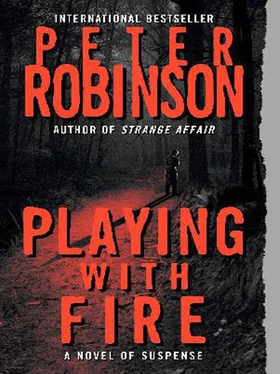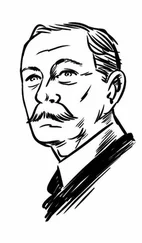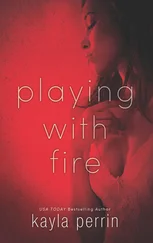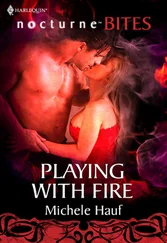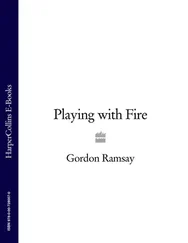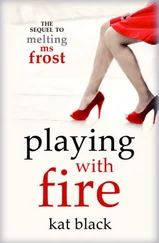“Anyway,” Glendenning went on, “if he was an artist, he was probably a boozer. Usually are in my experience.”
Annie said nothing, though her father, Ray, was an artist, and a boozer. She stood beside Banks, eyes fixed on the doctor, already looking a little pale. Banks knew she didn’t like postmortems – nobody really did except, arguably, the pathologist – but the more she attended, the sooner she’d get used to them.
“He’s got burns over about seventy-five percent of the body’s surface area. The most severe burning, the greatest combination of third-and fourth-degree burning, occurs in the upper body area.”
“That would be the area closest to the point of origin,” said Geoff Hamilton, cool and glum-looking as ever.
Dr. Glendenning nodded. “Makes sense. Mostly what we’ve got is full-thickness burning on the front upper body. You can see where the surface looks black and charred. That’s caused by boiling subcutaneous fat. The human body keeps on burning long after the fire’s been put out. Sort of like a candle, burning in its own fat.”
Banks noticed Annie make an expression of distaste.
“Farther down,” Glendenning continued, “on the legs and feet, for example, you can see the skin is pink and mottled in places, covered with blisters. That indicates brief exposure and lower temperature.”
When Dr. Glendenning got to the external examination of the victim’s head, Banks noticed what looked like skull fractures. “Found something, Doc?” he asked.
“Look, I’ve told you before not to call me Doc. It’s lacking in respect.”
“But have you found evidence of blows to the head?”
Glendenning bent over and probed the wounds, examining them carefully. “I don’t think so,” he said.
“But that’s what they look like to me,” Annie said.
“To you, lassie, maybe. But to me, they look like fractures caused by the heat.”
“The heat causes fractures?” Annie said.
Dr. Glendenning sighed. Banks could imagine the sort of teacher he’d be and how he’d terrify the poor medical students.
“Of course it does,” he said. “Heat contracts the skin and causes splits that may easily be interpreted as cuts inflicted during life. It can also cause fractures in the long bones of the arms and legs, or make them so bloody brittle that they’re fractured while the body is being moved. Remember, we’re sixty-six percent water, and fire is a great dehydrator.”
“But what about the skull?” Annie asked.
Glendenning looked at her, a glint in his eye. “The fractures are caused by pressure. The brain and the blood start to boil, and the steam needs an outlet, so it blows a hole in the skull. Pop. Just like a bottle of champagne.”
Annie shuddered. Even Banks felt a little queasy. Dr. Glendenning went back to work, a mischievous grin on his face.
“Anyway,” he went on, “skull fractures caused by fire often radiate along suture lines, the weakest point in the skull’s surface, and that’s the case here. Also, the skull splinters haven’t been driven into the brain matter, which would most likely be the case if blunt-instrument trauma were present. They’ve been forced outward.”
“So you’re saying he wasn’t hit over the head?”
“I’m saying nothing of the kind,” Glendenning said. “I’m only saying it seems unlikely. That’s typical of you, Banks, jumping to conclusions when you’ve got only part of the evidence, going off half-cocked. What about a bit of scientific method, laddie? Haven’t you been reading your Sherlock Holmes lately?”
“I know that when you have eliminated the impossible, whatever remains, however improbable, must be the truth. Or something like that.”
“Well, in this case,” said Glendenning, “almost anything’s still possible. Your report mentioned that the body was covered by debris, and I’ve seen the crime scene photos and sketches. The damage might have been caused by a section of the ceiling falling on the deceased after his death.”
“I suppose it could have happened that way,” said Banks.
“Definitely possible,” said Geoff Hamilton.
“I’m glad you both agree,” Glendenning said.
“On the other hand, though,” Banks argued, “wouldn’t you expect to find skull splinters in the brain if that were the case?”
Glendenning graced him with a rare smile. “You’re learning, laddie. Anyway, we don’t even know whether the injury was post-or antemortem yet. That’s my point.”
“Do you think you could find out?”
Glendenning rolled his eyes. “Do I think I could find out?” he mimicked, then went back to the body. “Well, why don’t we start by looking for signs of smoke inhalation?” He held out his hand theatrically. “Scalpel.”
Wendy Gauge suppressed a smile as she handed him the required instrument, and the pathologist bent over the corpse. The nose had burned away, along with enough skin and flesh to allow the chin and jawbone to show through in places. Glendenning worked away at exposing the tracheal area and bronchial passage, parts of which Banks could see were black with soot or charring, then he bent over the body again. “There’s definitely some thermal injury to the mouth, nose and upper airways,” he said, “but that’s not unusual, and it doesn’t tell us much.” He poked around some more. “There’s soot present, but not a great deal. In fact, in this case, there’s little enough to conclude that he was still breathing, but shallowly.”
“Was he unconscious?” Banks asked.
“Very likely.”
“So that blow to the head might have been administered prior to the starting of the fire? It might have caused the unconsciousness?”
“Hold your horses.” Dr. Glendenning bent over the body again. “I’ve already told you; that blow was more likely caused by the fire or falling debris than by human force. Deposition of soot on the tongue, in the nares, the oropharynx and the nasopharynx, all of which we have here, cannot be held to imply life during the fire.”
“So he could have been already dead?”
Glendenning gave Banks a nasty look and went on. “Traces of soot below the larynx would indicate that the victim was alive at the start of the fire.”
“And is there any?” Banks asked.
“A little. Right now, we need to dig deeper.” Glendenning gave the go-ahead and Wendy Gauge wielded her own scalpel and made the customary Y-shaped incision. The blackened skin, which had been dried by the fire and then wetted by the firefighters’ hoses, peeled back like burned paper. And there it was, the sickly smell of death. Cooked or raw, it amounted to the same thing. “Hmm,” said Glendenning. “You can see how deep the burning goes in some places. It’s never uniform, for a number of reasons, including the fact that your skin’s thicker in some places than in others.”
“Needs to be around you,” said Banks.
Glendenning pointedly ignored him. “There’s some exaggerated redness of the blood,” he said, “which indicates the presence of carbon monoxide. We’ll know the exact amounts when that incompetent pillock Billings brings the results back from the lab.”
Banks remembered the day he found his old chief constable, Jimmy Riddle, dead in his garage from carbon monoxide poisoning. Suicide. His face had been cherry-red. “How much carbon monoxide does it take to cause death?” he asked.
“Anything over forty percent is likely to cause impaired judgment, unconsciousness and death, but it depends on the person’s state of health. The generally accepted fatal level is fifty percent. All right, Wendy, you can go on now.”
“Yes, Doctor.” Wendy Gauge pulled up the chest flap and took a bone cutter to the rib cage, which she cracked open to expose the inner organs.
Читать дальше
